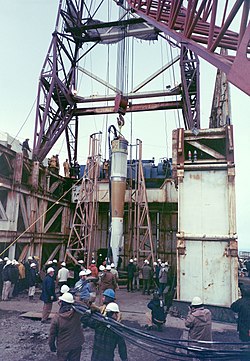
Back أمشيتكا Arabic Islla Amchitka AST Amçitka adası Azerbaijani Амчытка Byelorussian Amchitka Catalan Amchitka Island CEB Amčitka Czech Amchitka German Amchitka Esperanto Isla Amchitka Spanish
| Amchitka Underground Test Site | |
|---|---|
 Cannikin warhead being lowered into test shaft | |
 Location of the site | |
| Coordinates | 51°32′32″N 178°59′00″E / 51.54222°N 178.98333°E |
| Type | Nuclear testing range |
| Site information | |
| Operator | United States Department of Energy |
| Status | Inactive |
| Site history | |
| In use | 1965–1971 |
| Test information | |
| Thermonuclear tests | 3 |
| Remediation | 2001–2025 (DoE estimate) |
Amchitka (/æmˈtʃɪtkə/; Aleut: Amchixtax̂;[1][page needed]) is a volcanic, tectonically unstable and uninhabited island in the Rat Islands group of the Aleutian Islands in southwest Alaska. It is part of the Alaska Maritime National Wildlife Refuge. The island, with a land area of roughly 116 square miles (300 km2), is about 42 miles (68 km) long and 1 to 4 miles (1.6 to 6.4 km) wide.[2] The area has a maritime climate, with many storms, and mostly overcast skies.
Amchitka was populated for more than 2,500 years by the Aleut people, but has had no permanent population since 1832. The island has been part of the United States since the Alaska Purchase of 1867. During World War II, it was used as an airfield by US forces in the Aleutian Islands Campaign.
Amchitka was selected by the United States Atomic Energy Commission (AEC) to be the site for underground detonations of nuclear weapons. Three such tests were carried out: Long Shot, an 80-kiloton (330 TJ) blast in 1965; Milrow, a 1-megaton (4.2 PJ) blast in 1969; and Cannikin in 1971 – at 5 Mt (21 PJ), the largest underground test ever conducted by the United States.[3][4] The tests were highly controversial, with environmental groups fearing that the Cannikin explosion, in particular, would cause severe earthquakes and tsunamis. Amchitka is no longer used for nuclear testing. It is still monitored for the leakage of radioactive materials.
- ^ Bergsland, K. (1994). Aleut Dictionary. Fairbanks: Alaska Native Language Center. ISBN 1-55500-047-9.
- ^ Faller, S. H.; D. E. Farmer (1997). "Long Term Hydrological Monitoring Program" (PDF). Department of Energy. p. 1. EP A-402-R-98-002. Archived (PDF) from the original on June 30, 2007. Retrieved October 11, 2006.
- ^ "Alaskan blast fails to cause quakes, waves or radiation". Spokesman-Review. (Spokane, Washington). Associated Press. November 7, 1971. p. 1.
- ^ "Nuclear test sites studied by scientists". The Bulletin. (Bend, Oregon). UPI. November 8, 1971. p. 1.